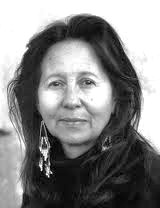“WE ARE MANY, WE ARE ONE”
The chilly January winds
blew across Montana, heralding the coming Second World War, when this little
girl was born at the Jesuit Mission on the Salish Flathead Reservation. She was
not pure Flathead but Cree, Shoshone, and French as well. When Jaune was two
years old, she and her sister were abandoned by their mother. The girls lived
with their father, an illiterate horse trader, who moved the little family
around the northwest U.S. Visits to relatives on the Montana reservation were
rare because their father didn’t have the money to take them. They lived from
time to time in foster homes.
She was 36 by the time she
completed her B.A. in Art, and 40 when receiving her Master of Fine Arts
degree. It’s funny because Jaune had been earning a living as an artist for
several years. She hoped to teach art on a reservation but there were few
opportunities. She continued to be a mentor to young native artists, especially
to the girls who had always been told that art was something beyond their
ability.
Her art is a fusion of her
own cultural experiences and values, and contemporary Euro-American tradition.
It is filled with political subject matter. There is sarcasm, even rage,
in
her work but it is tempered by popular imagery, parody, and humor. It can be
thought provoking and raises questions to dispel the myths about Native
Americans.
She began to establish
herself as an artist in the mid-1970’s with some successes in the business of
art. Now Jaune Quick-to-See Smith was able to put together her talent (art) and
her passion (activism).
She had always been
inspired by the words of Chief Seattle, a prominent mid-nineteenth century
Suquamish leader, who urged environmental responsibility and warned of the
exploitation of the natural world. He also pushed for respect for Native
American land rights. Jaune occasionally paints his words directly onto her
artwork.
In 1985, Jaune
Quick-to-See Smith gathered together thirty Native American female artists and
travelled with them across the country exhibiting their work. The mediums
included painting, sculpture, photographs, as well as bead work and weaving.
Today she lives in
Corrales, New Mexico, but is far from retirement. Jaune has had more than 90
solo exhibitions and lectured at 185 museums and schools (including five in
China). Her art can be found in the Museum of Modern Art and the Whitney
Museum, both in New York, The Museum of Mankind in Vienna, The Smithsonian, The
National Museum of Women in the Arts, and The Museum of Modern Art in Ecuador.
When asked to describe
herself, Jaune Quick-to-See Smith replied, “harbinger, mediator, bridge
builder.” That sums it up pretty well.
You
can link to see some of her paintings at this address (courtesy of Bluffton
College):






No comments:
Post a Comment